A Comprehensive Report: Criminology Theories and Their Application
VerifiedAdded on 2020/07/23
|11
|3062
|78
Report
AI Summary
This report provides an overview of key theories in criminology and justice. It begins with an introduction to the field, defining its scope and relevance. The main body of the report delves into three prominent theories: social learning theory, psychoanalytic theory, and rational choice theory. Social learning theory is explored, detailing how individuals learn through observation, imitation, and modeling, with examples like the Bobo doll experiment. The report then examines psychoanalytic theory, focusing on the unconscious mind and its influence on criminal behavior, including discussions of Freudian concepts and psychological profiling. Finally, the report analyzes rational choice theory, emphasizing economic principles and the idea that individuals make logical decisions to maximize their benefits, along with the importance of deterrence. The report concludes by summarizing the key arguments and providing a comprehensive understanding of the theories and their applications within the context of criminology.
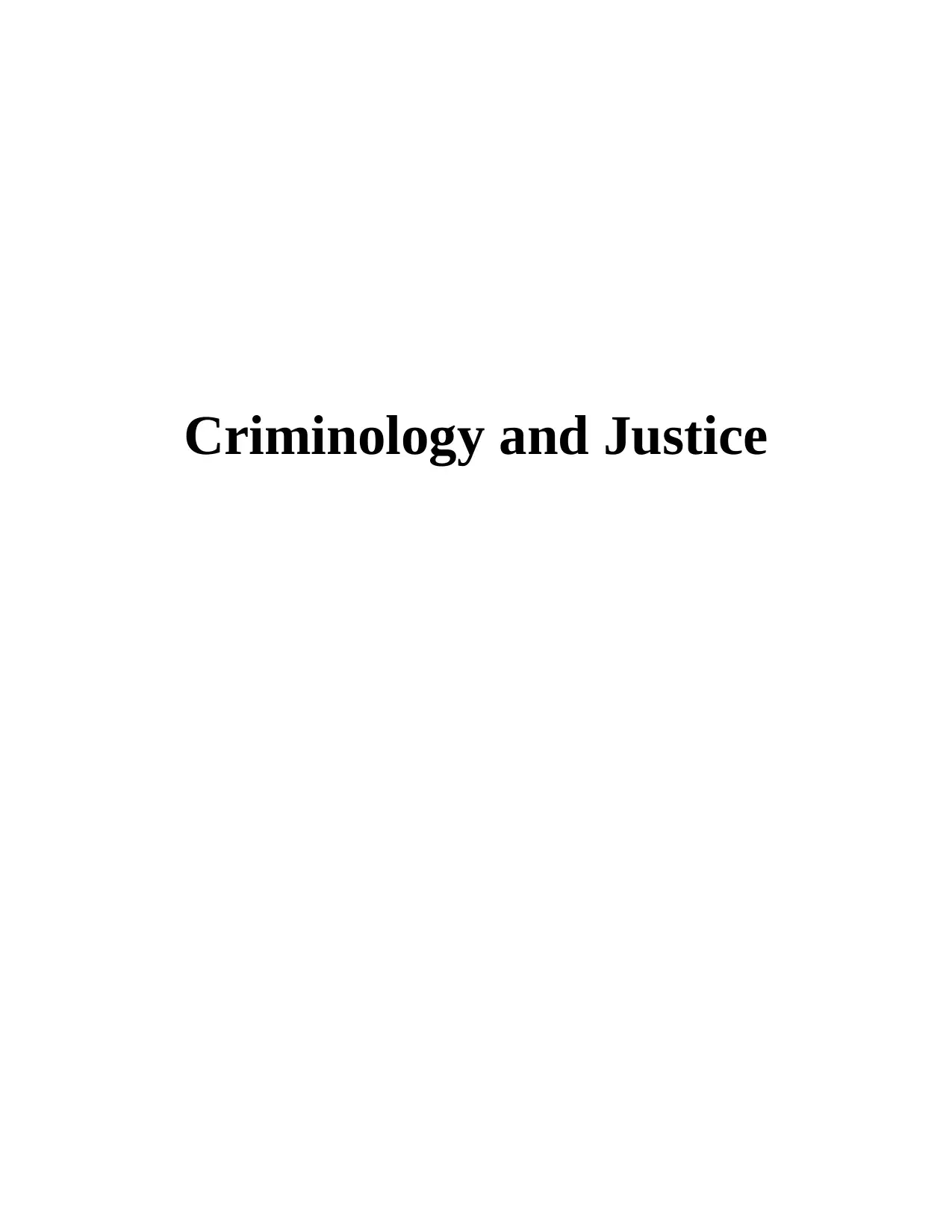
Criminology and Justice
Paraphrase This Document
Need a fresh take? Get an instant paraphrase of this document with our AI Paraphraser
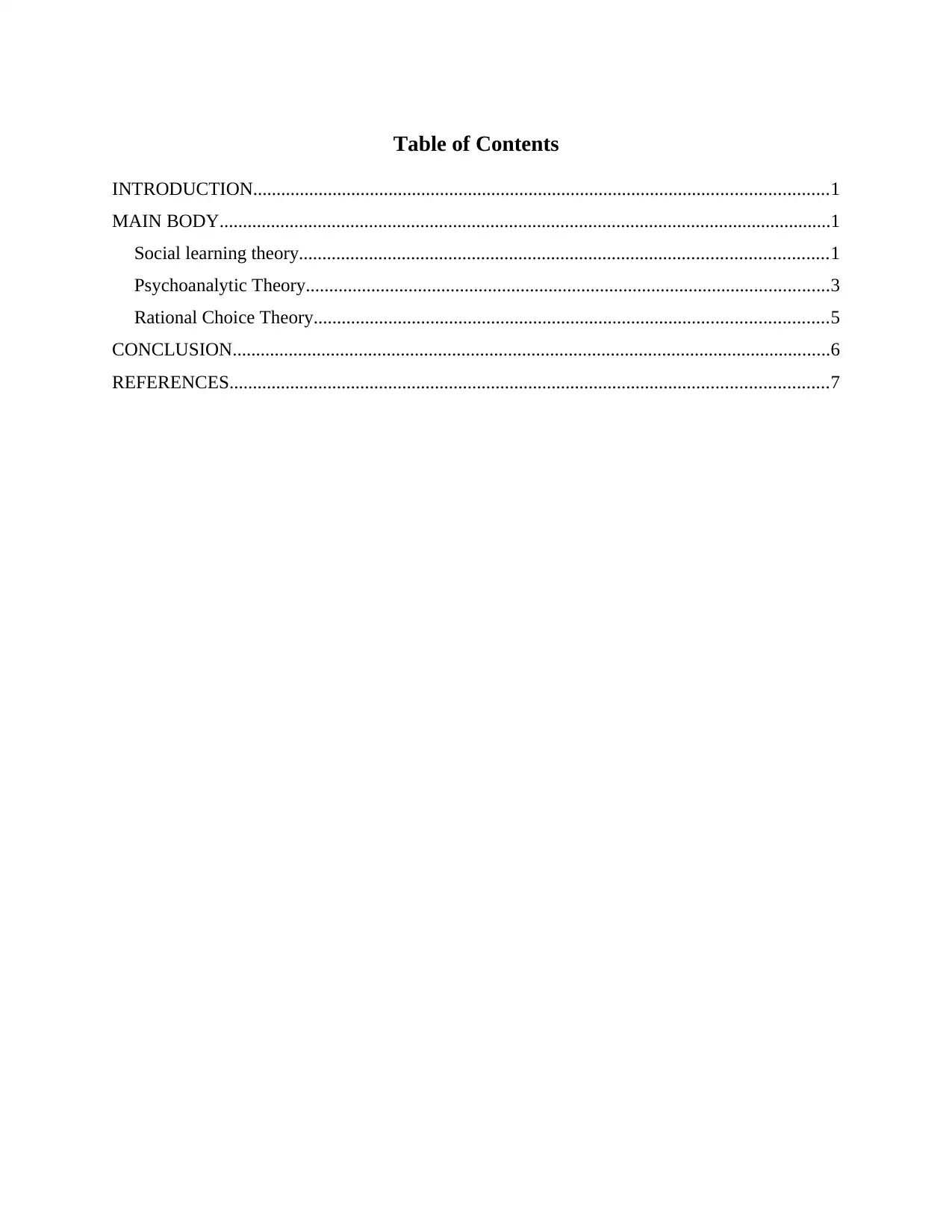
Table of Contents
INTRODUCTION...........................................................................................................................1
MAIN BODY...................................................................................................................................1
Social learning theory.................................................................................................................1
Psychoanalytic Theory................................................................................................................3
Rational Choice Theory..............................................................................................................5
CONCLUSION................................................................................................................................6
REFERENCES................................................................................................................................7
INTRODUCTION...........................................................................................................................1
MAIN BODY...................................................................................................................................1
Social learning theory.................................................................................................................1
Psychoanalytic Theory................................................................................................................3
Rational Choice Theory..............................................................................................................5
CONCLUSION................................................................................................................................6
REFERENCES................................................................................................................................7
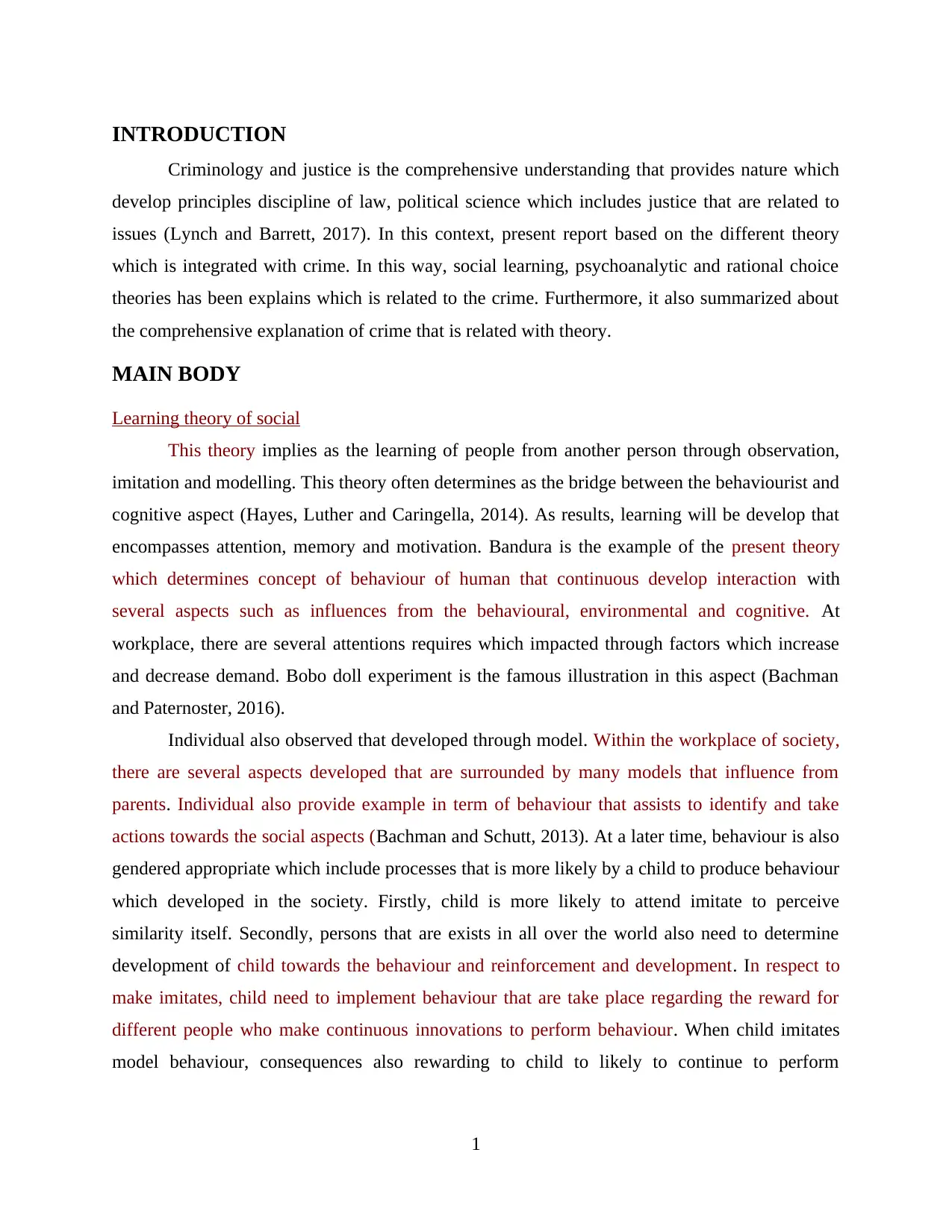
INTRODUCTION
Criminology and justice is the comprehensive understanding that provides nature which
develop principles discipline of law, political science which includes justice that are related to
issues (Lynch and Barrett, 2017). In this context, present report based on the different theory
which is integrated with crime. In this way, social learning, psychoanalytic and rational choice
theories has been explains which is related to the crime. Furthermore, it also summarized about
the comprehensive explanation of crime that is related with theory.
MAIN BODY
Learning theory of social
This theory implies as the learning of people from another person through observation,
imitation and modelling. This theory often determines as the bridge between the behaviourist and
cognitive aspect (Hayes, Luther and Caringella, 2014). As results, learning will be develop that
encompasses attention, memory and motivation. Bandura is the example of the present theory
which determines concept of behaviour of human that continuous develop interaction with
several aspects such as influences from the behavioural, environmental and cognitive. At
workplace, there are several attentions requires which impacted through factors which increase
and decrease demand. Bobo doll experiment is the famous illustration in this aspect (Bachman
and Paternoster, 2016).
Individual also observed that developed through model. Within the workplace of society,
there are several aspects developed that are surrounded by many models that influence from
parents. Individual also provide example in term of behaviour that assists to identify and take
actions towards the social aspects (Bachman and Schutt, 2013). At a later time, behaviour is also
gendered appropriate which include processes that is more likely by a child to produce behaviour
which developed in the society. Firstly, child is more likely to attend imitate to perceive
similarity itself. Secondly, persons that are exists in all over the world also need to determine
development of child towards the behaviour and reinforcement and development. In respect to
make imitates, child need to implement behaviour that are take place regarding the reward for
different people who make continuous innovations to perform behaviour. When child imitates
model behaviour, consequences also rewarding to child to likely to continue to perform
1
Criminology and justice is the comprehensive understanding that provides nature which
develop principles discipline of law, political science which includes justice that are related to
issues (Lynch and Barrett, 2017). In this context, present report based on the different theory
which is integrated with crime. In this way, social learning, psychoanalytic and rational choice
theories has been explains which is related to the crime. Furthermore, it also summarized about
the comprehensive explanation of crime that is related with theory.
MAIN BODY
Learning theory of social
This theory implies as the learning of people from another person through observation,
imitation and modelling. This theory often determines as the bridge between the behaviourist and
cognitive aspect (Hayes, Luther and Caringella, 2014). As results, learning will be develop that
encompasses attention, memory and motivation. Bandura is the example of the present theory
which determines concept of behaviour of human that continuous develop interaction with
several aspects such as influences from the behavioural, environmental and cognitive. At
workplace, there are several attentions requires which impacted through factors which increase
and decrease demand. Bobo doll experiment is the famous illustration in this aspect (Bachman
and Paternoster, 2016).
Individual also observed that developed through model. Within the workplace of society,
there are several aspects developed that are surrounded by many models that influence from
parents. Individual also provide example in term of behaviour that assists to identify and take
actions towards the social aspects (Bachman and Schutt, 2013). At a later time, behaviour is also
gendered appropriate which include processes that is more likely by a child to produce behaviour
which developed in the society. Firstly, child is more likely to attend imitate to perceive
similarity itself. Secondly, persons that are exists in all over the world also need to determine
development of child towards the behaviour and reinforcement and development. In respect to
make imitates, child need to implement behaviour that are take place regarding the reward for
different people who make continuous innovations to perform behaviour. When child imitates
model behaviour, consequences also rewarding to child to likely to continue to perform
1
⊘ This is a preview!⊘
Do you want full access?
Subscribe today to unlock all pages.

Trusted by 1+ million students worldwide
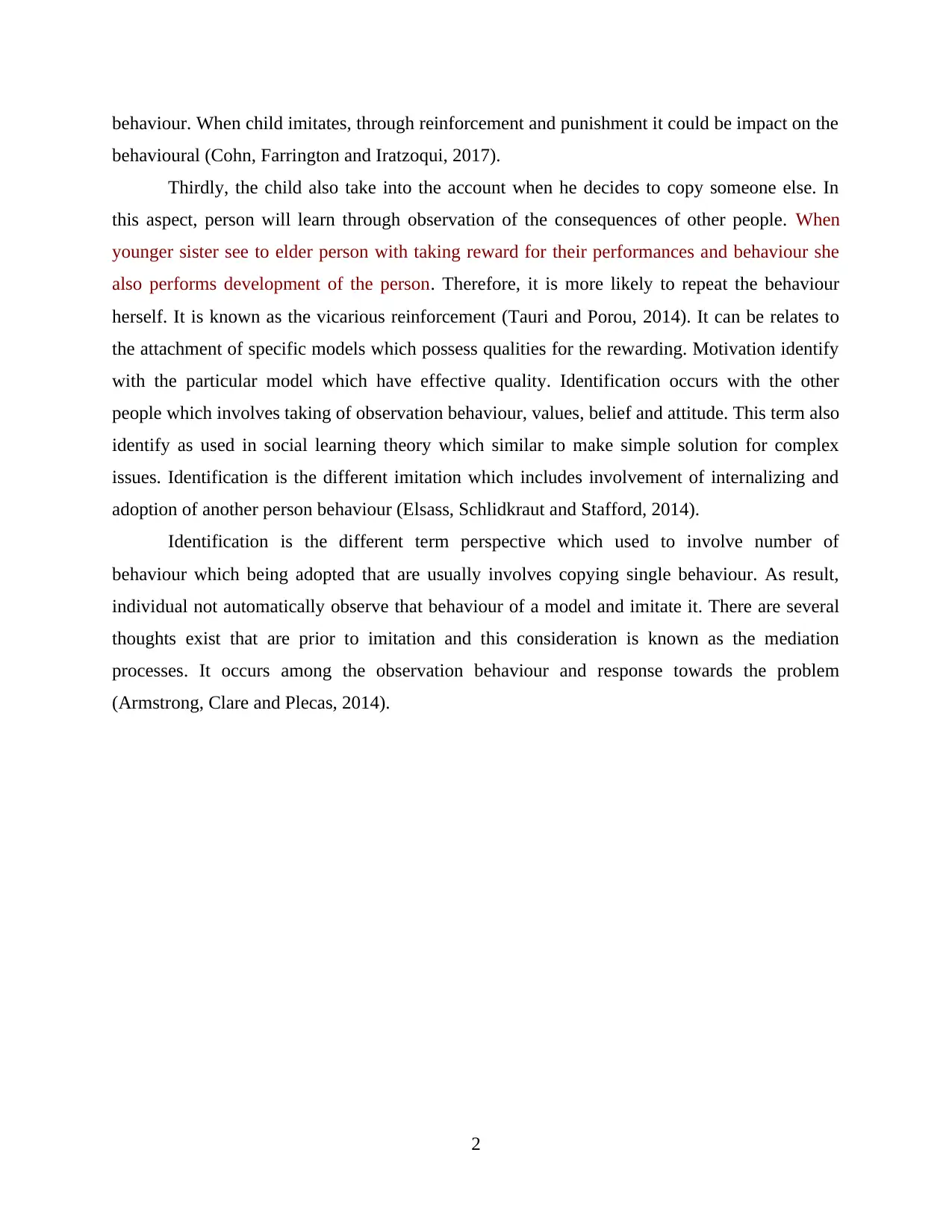
behaviour. When child imitates, through reinforcement and punishment it could be impact on the
behavioural (Cohn, Farrington and Iratzoqui, 2017).
Thirdly, the child also take into the account when he decides to copy someone else. In
this aspect, person will learn through observation of the consequences of other people. When
younger sister see to elder person with taking reward for their performances and behaviour she
also performs development of the person. Therefore, it is more likely to repeat the behaviour
herself. It is known as the vicarious reinforcement (Tauri and Porou, 2014). It can be relates to
the attachment of specific models which possess qualities for the rewarding. Motivation identify
with the particular model which have effective quality. Identification occurs with the other
people which involves taking of observation behaviour, values, belief and attitude. This term also
identify as used in social learning theory which similar to make simple solution for complex
issues. Identification is the different imitation which includes involvement of internalizing and
adoption of another person behaviour (Elsass, Schlidkraut and Stafford, 2014).
Identification is the different term perspective which used to involve number of
behaviour which being adopted that are usually involves copying single behaviour. As result,
individual not automatically observe that behaviour of a model and imitate it. There are several
thoughts exist that are prior to imitation and this consideration is known as the mediation
processes. It occurs among the observation behaviour and response towards the problem
(Armstrong, Clare and Plecas, 2014).
2
behavioural (Cohn, Farrington and Iratzoqui, 2017).
Thirdly, the child also take into the account when he decides to copy someone else. In
this aspect, person will learn through observation of the consequences of other people. When
younger sister see to elder person with taking reward for their performances and behaviour she
also performs development of the person. Therefore, it is more likely to repeat the behaviour
herself. It is known as the vicarious reinforcement (Tauri and Porou, 2014). It can be relates to
the attachment of specific models which possess qualities for the rewarding. Motivation identify
with the particular model which have effective quality. Identification occurs with the other
people which involves taking of observation behaviour, values, belief and attitude. This term also
identify as used in social learning theory which similar to make simple solution for complex
issues. Identification is the different imitation which includes involvement of internalizing and
adoption of another person behaviour (Elsass, Schlidkraut and Stafford, 2014).
Identification is the different term perspective which used to involve number of
behaviour which being adopted that are usually involves copying single behaviour. As result,
individual not automatically observe that behaviour of a model and imitate it. There are several
thoughts exist that are prior to imitation and this consideration is known as the mediation
processes. It occurs among the observation behaviour and response towards the problem
(Armstrong, Clare and Plecas, 2014).
2
Paraphrase This Document
Need a fresh take? Get an instant paraphrase of this document with our AI Paraphraser
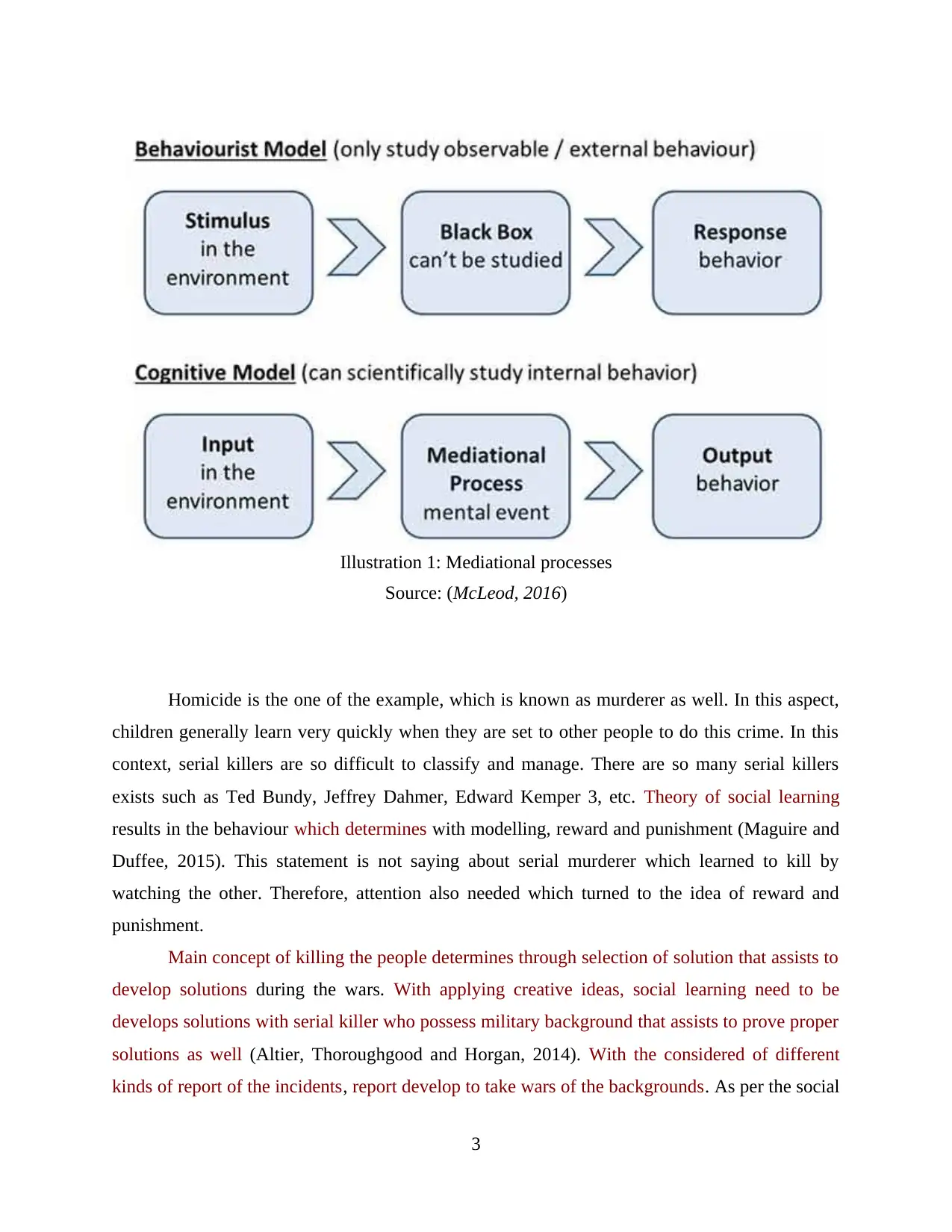
Homicide is the one of the example, which is known as murderer as well. In this aspect,
children generally learn very quickly when they are set to other people to do this crime. In this
context, serial killers are so difficult to classify and manage. There are so many serial killers
exists such as Ted Bundy, Jeffrey Dahmer, Edward Kemper 3, etc. Theory of social learning
results in the behaviour which determines with modelling, reward and punishment (Maguire and
Duffee, 2015). This statement is not saying about serial murderer which learned to kill by
watching the other. Therefore, attention also needed which turned to the idea of reward and
punishment.
Main concept of killing the people determines through selection of solution that assists to
develop solutions during the wars. With applying creative ideas, social learning need to be
develops solutions with serial killer who possess military background that assists to prove proper
solutions as well (Altier, Thoroughgood and Horgan, 2014). With the considered of different
kinds of report of the incidents, report develop to take wars of the backgrounds. As per the social
3
Illustration 1: Mediational processes
Source: (McLeod, 2016)
children generally learn very quickly when they are set to other people to do this crime. In this
context, serial killers are so difficult to classify and manage. There are so many serial killers
exists such as Ted Bundy, Jeffrey Dahmer, Edward Kemper 3, etc. Theory of social learning
results in the behaviour which determines with modelling, reward and punishment (Maguire and
Duffee, 2015). This statement is not saying about serial murderer which learned to kill by
watching the other. Therefore, attention also needed which turned to the idea of reward and
punishment.
Main concept of killing the people determines through selection of solution that assists to
develop solutions during the wars. With applying creative ideas, social learning need to be
develops solutions with serial killer who possess military background that assists to prove proper
solutions as well (Altier, Thoroughgood and Horgan, 2014). With the considered of different
kinds of report of the incidents, report develop to take wars of the backgrounds. As per the social
3
Illustration 1: Mediational processes
Source: (McLeod, 2016)
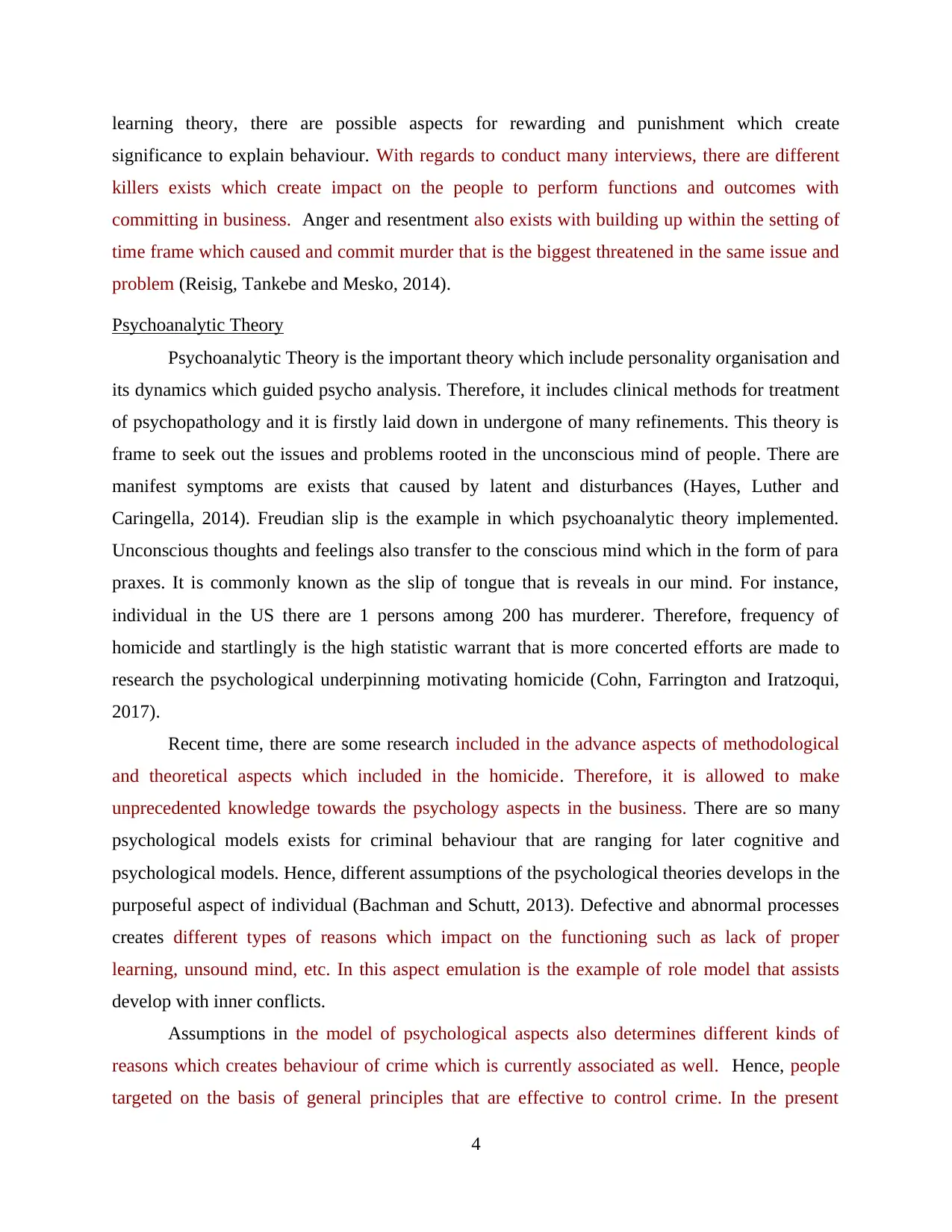
learning theory, there are possible aspects for rewarding and punishment which create
significance to explain behaviour. With regards to conduct many interviews, there are different
killers exists which create impact on the people to perform functions and outcomes with
committing in business. Anger and resentment also exists with building up within the setting of
time frame which caused and commit murder that is the biggest threatened in the same issue and
problem (Reisig, Tankebe and Mesko, 2014).
Psychoanalytic Theory
Psychoanalytic Theory is the important theory which include personality organisation and
its dynamics which guided psycho analysis. Therefore, it includes clinical methods for treatment
of psychopathology and it is firstly laid down in undergone of many refinements. This theory is
frame to seek out the issues and problems rooted in the unconscious mind of people. There are
manifest symptoms are exists that caused by latent and disturbances (Hayes, Luther and
Caringella, 2014). Freudian slip is the example in which psychoanalytic theory implemented.
Unconscious thoughts and feelings also transfer to the conscious mind which in the form of para
praxes. It is commonly known as the slip of tongue that is reveals in our mind. For instance,
individual in the US there are 1 persons among 200 has murderer. Therefore, frequency of
homicide and startlingly is the high statistic warrant that is more concerted efforts are made to
research the psychological underpinning motivating homicide (Cohn, Farrington and Iratzoqui,
2017).
Recent time, there are some research included in the advance aspects of methodological
and theoretical aspects which included in the homicide. Therefore, it is allowed to make
unprecedented knowledge towards the psychology aspects in the business. There are so many
psychological models exists for criminal behaviour that are ranging for later cognitive and
psychological models. Hence, different assumptions of the psychological theories develops in the
purposeful aspect of individual (Bachman and Schutt, 2013). Defective and abnormal processes
creates different types of reasons which impact on the functioning such as lack of proper
learning, unsound mind, etc. In this aspect emulation is the example of role model that assists
develop with inner conflicts.
Assumptions in the model of psychological aspects also determines different kinds of
reasons which creates behaviour of crime which is currently associated as well. Hence, people
targeted on the basis of general principles that are effective to control crime. In the present
4
significance to explain behaviour. With regards to conduct many interviews, there are different
killers exists which create impact on the people to perform functions and outcomes with
committing in business. Anger and resentment also exists with building up within the setting of
time frame which caused and commit murder that is the biggest threatened in the same issue and
problem (Reisig, Tankebe and Mesko, 2014).
Psychoanalytic Theory
Psychoanalytic Theory is the important theory which include personality organisation and
its dynamics which guided psycho analysis. Therefore, it includes clinical methods for treatment
of psychopathology and it is firstly laid down in undergone of many refinements. This theory is
frame to seek out the issues and problems rooted in the unconscious mind of people. There are
manifest symptoms are exists that caused by latent and disturbances (Hayes, Luther and
Caringella, 2014). Freudian slip is the example in which psychoanalytic theory implemented.
Unconscious thoughts and feelings also transfer to the conscious mind which in the form of para
praxes. It is commonly known as the slip of tongue that is reveals in our mind. For instance,
individual in the US there are 1 persons among 200 has murderer. Therefore, frequency of
homicide and startlingly is the high statistic warrant that is more concerted efforts are made to
research the psychological underpinning motivating homicide (Cohn, Farrington and Iratzoqui,
2017).
Recent time, there are some research included in the advance aspects of methodological
and theoretical aspects which included in the homicide. Therefore, it is allowed to make
unprecedented knowledge towards the psychology aspects in the business. There are so many
psychological models exists for criminal behaviour that are ranging for later cognitive and
psychological models. Hence, different assumptions of the psychological theories develops in the
purposeful aspect of individual (Bachman and Schutt, 2013). Defective and abnormal processes
creates different types of reasons which impact on the functioning such as lack of proper
learning, unsound mind, etc. In this aspect emulation is the example of role model that assists
develop with inner conflicts.
Assumptions in the model of psychological aspects also determines different kinds of
reasons which creates behaviour of crime which is currently associated as well. Hence, people
targeted on the basis of general principles that are effective to control crime. In the present
4
⊘ This is a preview!⊘
Do you want full access?
Subscribe today to unlock all pages.

Trusted by 1+ million students worldwide
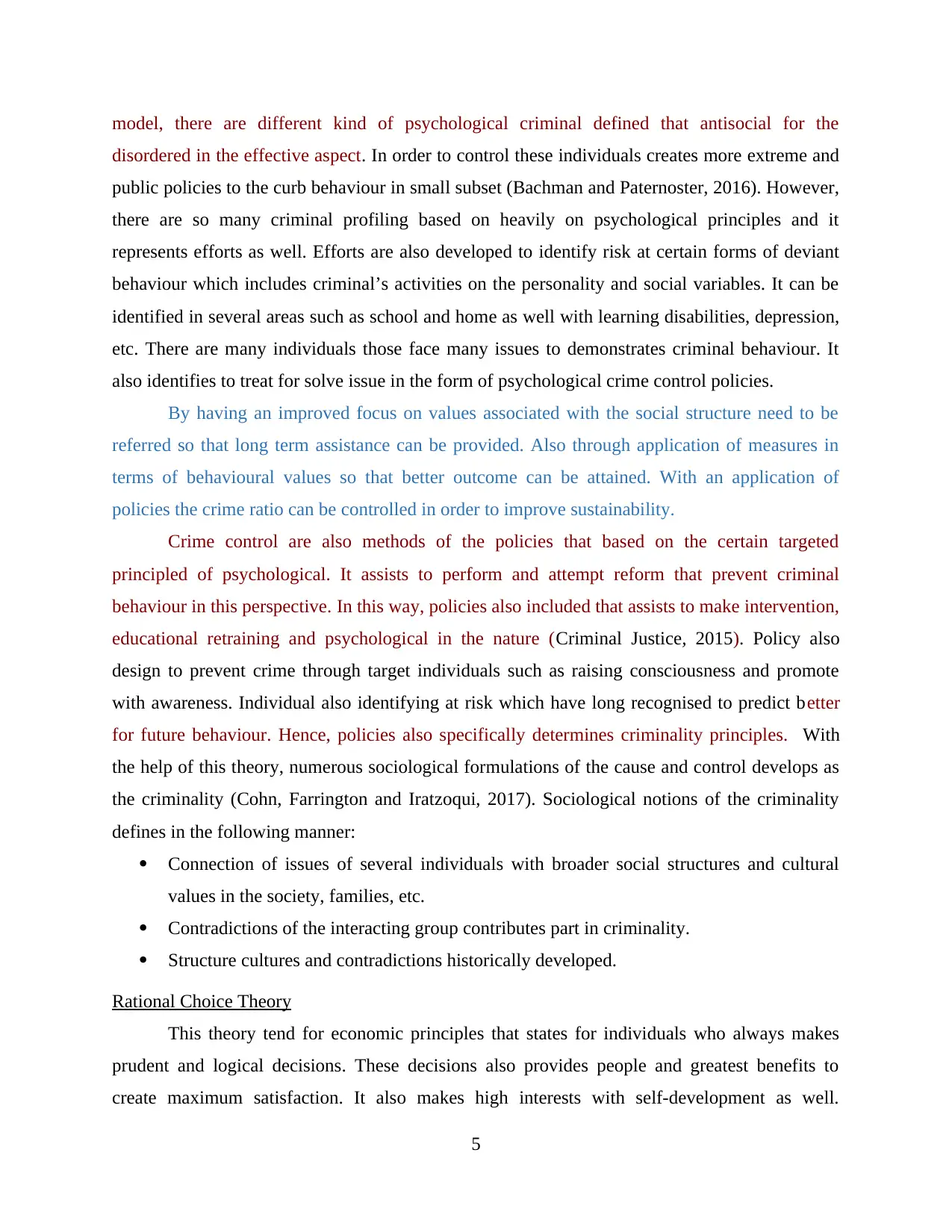
model, there are different kind of psychological criminal defined that antisocial for the
disordered in the effective aspect. In order to control these individuals creates more extreme and
public policies to the curb behaviour in small subset (Bachman and Paternoster, 2016). However,
there are so many criminal profiling based on heavily on psychological principles and it
represents efforts as well. Efforts are also developed to identify risk at certain forms of deviant
behaviour which includes criminal’s activities on the personality and social variables. It can be
identified in several areas such as school and home as well with learning disabilities, depression,
etc. There are many individuals those face many issues to demonstrates criminal behaviour. It
also identifies to treat for solve issue in the form of psychological crime control policies.
By having an improved focus on values associated with the social structure need to be
referred so that long term assistance can be provided. Also through application of measures in
terms of behavioural values so that better outcome can be attained. With an application of
policies the crime ratio can be controlled in order to improve sustainability.
Crime control are also methods of the policies that based on the certain targeted
principled of psychological. It assists to perform and attempt reform that prevent criminal
behaviour in this perspective. In this way, policies also included that assists to make intervention,
educational retraining and psychological in the nature (Criminal Justice, 2015). Policy also
design to prevent crime through target individuals such as raising consciousness and promote
with awareness. Individual also identifying at risk which have long recognised to predict better
for future behaviour. Hence, policies also specifically determines criminality principles. With
the help of this theory, numerous sociological formulations of the cause and control develops as
the criminality (Cohn, Farrington and Iratzoqui, 2017). Sociological notions of the criminality
defines in the following manner:
Connection of issues of several individuals with broader social structures and cultural
values in the society, families, etc.
Contradictions of the interacting group contributes part in criminality.
Structure cultures and contradictions historically developed.
Rational Choice Theory
This theory tend for economic principles that states for individuals who always makes
prudent and logical decisions. These decisions also provides people and greatest benefits to
create maximum satisfaction. It also makes high interests with self-development as well.
5
disordered in the effective aspect. In order to control these individuals creates more extreme and
public policies to the curb behaviour in small subset (Bachman and Paternoster, 2016). However,
there are so many criminal profiling based on heavily on psychological principles and it
represents efforts as well. Efforts are also developed to identify risk at certain forms of deviant
behaviour which includes criminal’s activities on the personality and social variables. It can be
identified in several areas such as school and home as well with learning disabilities, depression,
etc. There are many individuals those face many issues to demonstrates criminal behaviour. It
also identifies to treat for solve issue in the form of psychological crime control policies.
By having an improved focus on values associated with the social structure need to be
referred so that long term assistance can be provided. Also through application of measures in
terms of behavioural values so that better outcome can be attained. With an application of
policies the crime ratio can be controlled in order to improve sustainability.
Crime control are also methods of the policies that based on the certain targeted
principled of psychological. It assists to perform and attempt reform that prevent criminal
behaviour in this perspective. In this way, policies also included that assists to make intervention,
educational retraining and psychological in the nature (Criminal Justice, 2015). Policy also
design to prevent crime through target individuals such as raising consciousness and promote
with awareness. Individual also identifying at risk which have long recognised to predict better
for future behaviour. Hence, policies also specifically determines criminality principles. With
the help of this theory, numerous sociological formulations of the cause and control develops as
the criminality (Cohn, Farrington and Iratzoqui, 2017). Sociological notions of the criminality
defines in the following manner:
Connection of issues of several individuals with broader social structures and cultural
values in the society, families, etc.
Contradictions of the interacting group contributes part in criminality.
Structure cultures and contradictions historically developed.
Rational Choice Theory
This theory tend for economic principles that states for individuals who always makes
prudent and logical decisions. These decisions also provides people and greatest benefits to
create maximum satisfaction. It also makes high interests with self-development as well.
5
Paraphrase This Document
Need a fresh take? Get an instant paraphrase of this document with our AI Paraphraser
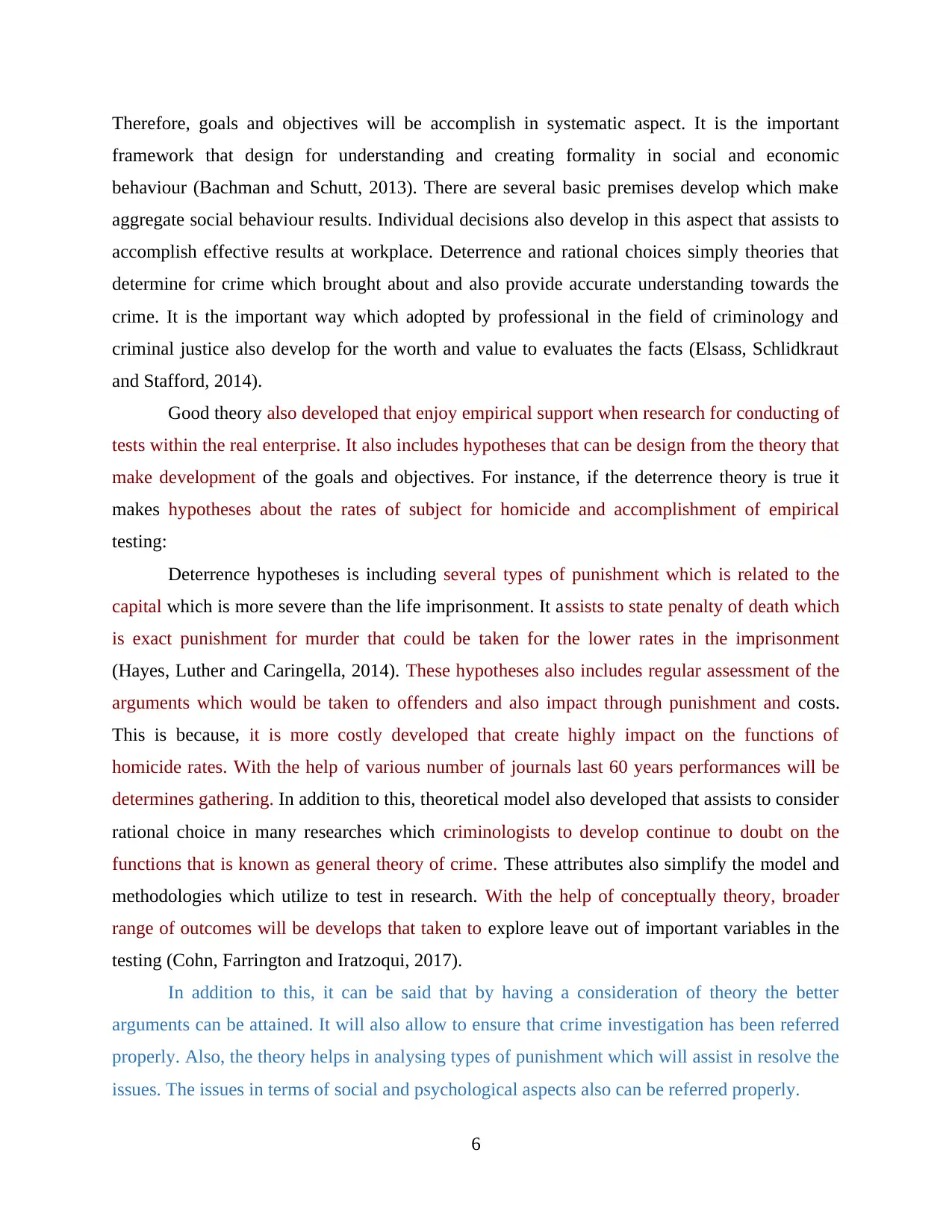
Therefore, goals and objectives will be accomplish in systematic aspect. It is the important
framework that design for understanding and creating formality in social and economic
behaviour (Bachman and Schutt, 2013). There are several basic premises develop which make
aggregate social behaviour results. Individual decisions also develop in this aspect that assists to
accomplish effective results at workplace. Deterrence and rational choices simply theories that
determine for crime which brought about and also provide accurate understanding towards the
crime. It is the important way which adopted by professional in the field of criminology and
criminal justice also develop for the worth and value to evaluates the facts (Elsass, Schlidkraut
and Stafford, 2014).
Good theory also developed that enjoy empirical support when research for conducting of
tests within the real enterprise. It also includes hypotheses that can be design from the theory that
make development of the goals and objectives. For instance, if the deterrence theory is true it
makes hypotheses about the rates of subject for homicide and accomplishment of empirical
testing:
Deterrence hypotheses is including several types of punishment which is related to the
capital which is more severe than the life imprisonment. It assists to state penalty of death which
is exact punishment for murder that could be taken for the lower rates in the imprisonment
(Hayes, Luther and Caringella, 2014). These hypotheses also includes regular assessment of the
arguments which would be taken to offenders and also impact through punishment and costs.
This is because, it is more costly developed that create highly impact on the functions of
homicide rates. With the help of various number of journals last 60 years performances will be
determines gathering. In addition to this, theoretical model also developed that assists to consider
rational choice in many researches which criminologists to develop continue to doubt on the
functions that is known as general theory of crime. These attributes also simplify the model and
methodologies which utilize to test in research. With the help of conceptually theory, broader
range of outcomes will be develops that taken to explore leave out of important variables in the
testing (Cohn, Farrington and Iratzoqui, 2017).
In addition to this, it can be said that by having a consideration of theory the better
arguments can be attained. It will also allow to ensure that crime investigation has been referred
properly. Also, the theory helps in analysing types of punishment which will assist in resolve the
issues. The issues in terms of social and psychological aspects also can be referred properly.
6
framework that design for understanding and creating formality in social and economic
behaviour (Bachman and Schutt, 2013). There are several basic premises develop which make
aggregate social behaviour results. Individual decisions also develop in this aspect that assists to
accomplish effective results at workplace. Deterrence and rational choices simply theories that
determine for crime which brought about and also provide accurate understanding towards the
crime. It is the important way which adopted by professional in the field of criminology and
criminal justice also develop for the worth and value to evaluates the facts (Elsass, Schlidkraut
and Stafford, 2014).
Good theory also developed that enjoy empirical support when research for conducting of
tests within the real enterprise. It also includes hypotheses that can be design from the theory that
make development of the goals and objectives. For instance, if the deterrence theory is true it
makes hypotheses about the rates of subject for homicide and accomplishment of empirical
testing:
Deterrence hypotheses is including several types of punishment which is related to the
capital which is more severe than the life imprisonment. It assists to state penalty of death which
is exact punishment for murder that could be taken for the lower rates in the imprisonment
(Hayes, Luther and Caringella, 2014). These hypotheses also includes regular assessment of the
arguments which would be taken to offenders and also impact through punishment and costs.
This is because, it is more costly developed that create highly impact on the functions of
homicide rates. With the help of various number of journals last 60 years performances will be
determines gathering. In addition to this, theoretical model also developed that assists to consider
rational choice in many researches which criminologists to develop continue to doubt on the
functions that is known as general theory of crime. These attributes also simplify the model and
methodologies which utilize to test in research. With the help of conceptually theory, broader
range of outcomes will be develops that taken to explore leave out of important variables in the
testing (Cohn, Farrington and Iratzoqui, 2017).
In addition to this, it can be said that by having a consideration of theory the better
arguments can be attained. It will also allow to ensure that crime investigation has been referred
properly. Also, the theory helps in analysing types of punishment which will assist in resolve the
issues. The issues in terms of social and psychological aspects also can be referred properly.
6
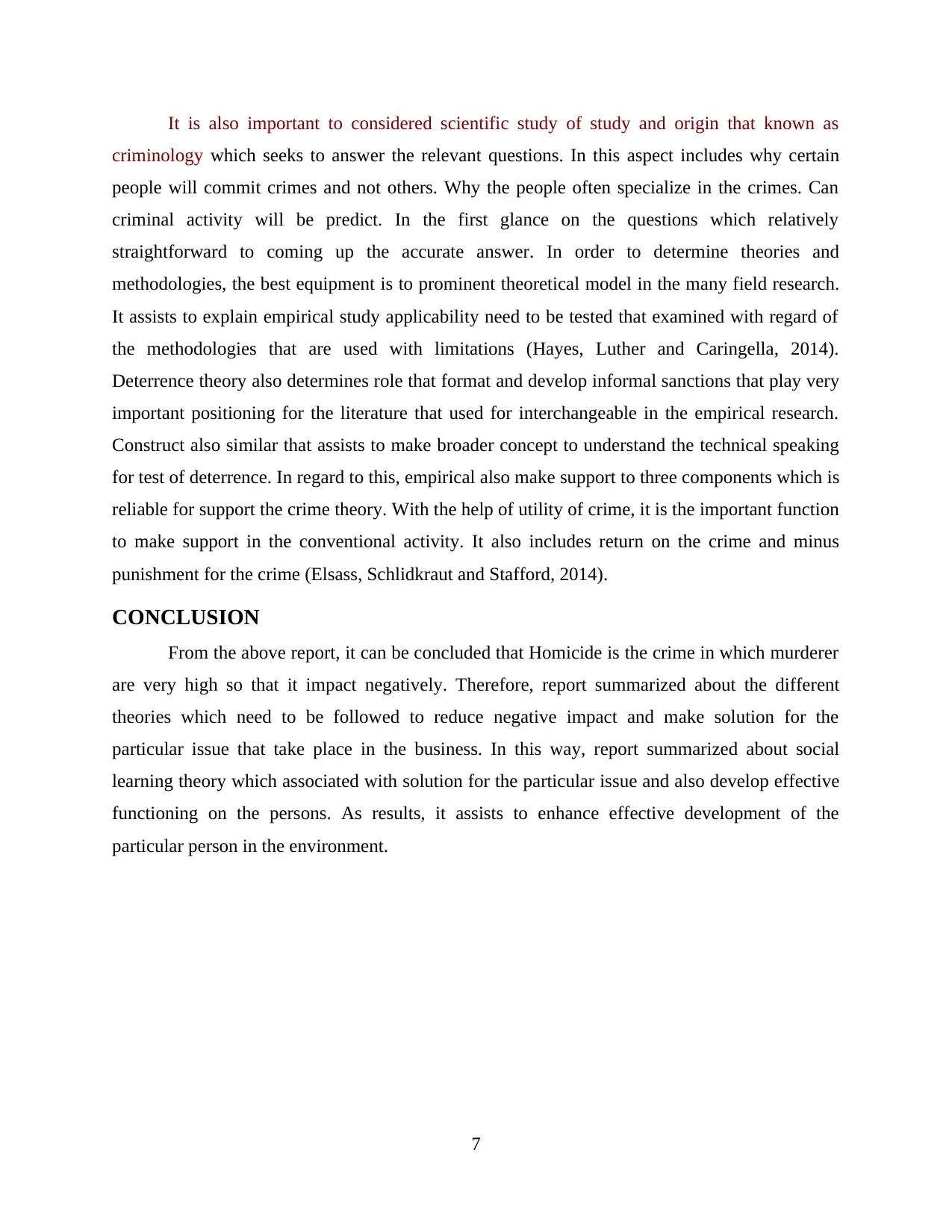
It is also important to considered scientific study of study and origin that known as
criminology which seeks to answer the relevant questions. In this aspect includes why certain
people will commit crimes and not others. Why the people often specialize in the crimes. Can
criminal activity will be predict. In the first glance on the questions which relatively
straightforward to coming up the accurate answer. In order to determine theories and
methodologies, the best equipment is to prominent theoretical model in the many field research.
It assists to explain empirical study applicability need to be tested that examined with regard of
the methodologies that are used with limitations (Hayes, Luther and Caringella, 2014).
Deterrence theory also determines role that format and develop informal sanctions that play very
important positioning for the literature that used for interchangeable in the empirical research.
Construct also similar that assists to make broader concept to understand the technical speaking
for test of deterrence. In regard to this, empirical also make support to three components which is
reliable for support the crime theory. With the help of utility of crime, it is the important function
to make support in the conventional activity. It also includes return on the crime and minus
punishment for the crime (Elsass, Schlidkraut and Stafford, 2014).
CONCLUSION
From the above report, it can be concluded that Homicide is the crime in which murderer
are very high so that it impact negatively. Therefore, report summarized about the different
theories which need to be followed to reduce negative impact and make solution for the
particular issue that take place in the business. In this way, report summarized about social
learning theory which associated with solution for the particular issue and also develop effective
functioning on the persons. As results, it assists to enhance effective development of the
particular person in the environment.
7
criminology which seeks to answer the relevant questions. In this aspect includes why certain
people will commit crimes and not others. Why the people often specialize in the crimes. Can
criminal activity will be predict. In the first glance on the questions which relatively
straightforward to coming up the accurate answer. In order to determine theories and
methodologies, the best equipment is to prominent theoretical model in the many field research.
It assists to explain empirical study applicability need to be tested that examined with regard of
the methodologies that are used with limitations (Hayes, Luther and Caringella, 2014).
Deterrence theory also determines role that format and develop informal sanctions that play very
important positioning for the literature that used for interchangeable in the empirical research.
Construct also similar that assists to make broader concept to understand the technical speaking
for test of deterrence. In regard to this, empirical also make support to three components which is
reliable for support the crime theory. With the help of utility of crime, it is the important function
to make support in the conventional activity. It also includes return on the crime and minus
punishment for the crime (Elsass, Schlidkraut and Stafford, 2014).
CONCLUSION
From the above report, it can be concluded that Homicide is the crime in which murderer
are very high so that it impact negatively. Therefore, report summarized about the different
theories which need to be followed to reduce negative impact and make solution for the
particular issue that take place in the business. In this way, report summarized about social
learning theory which associated with solution for the particular issue and also develop effective
functioning on the persons. As results, it assists to enhance effective development of the
particular person in the environment.
7
⊘ This is a preview!⊘
Do you want full access?
Subscribe today to unlock all pages.

Trusted by 1+ million students worldwide
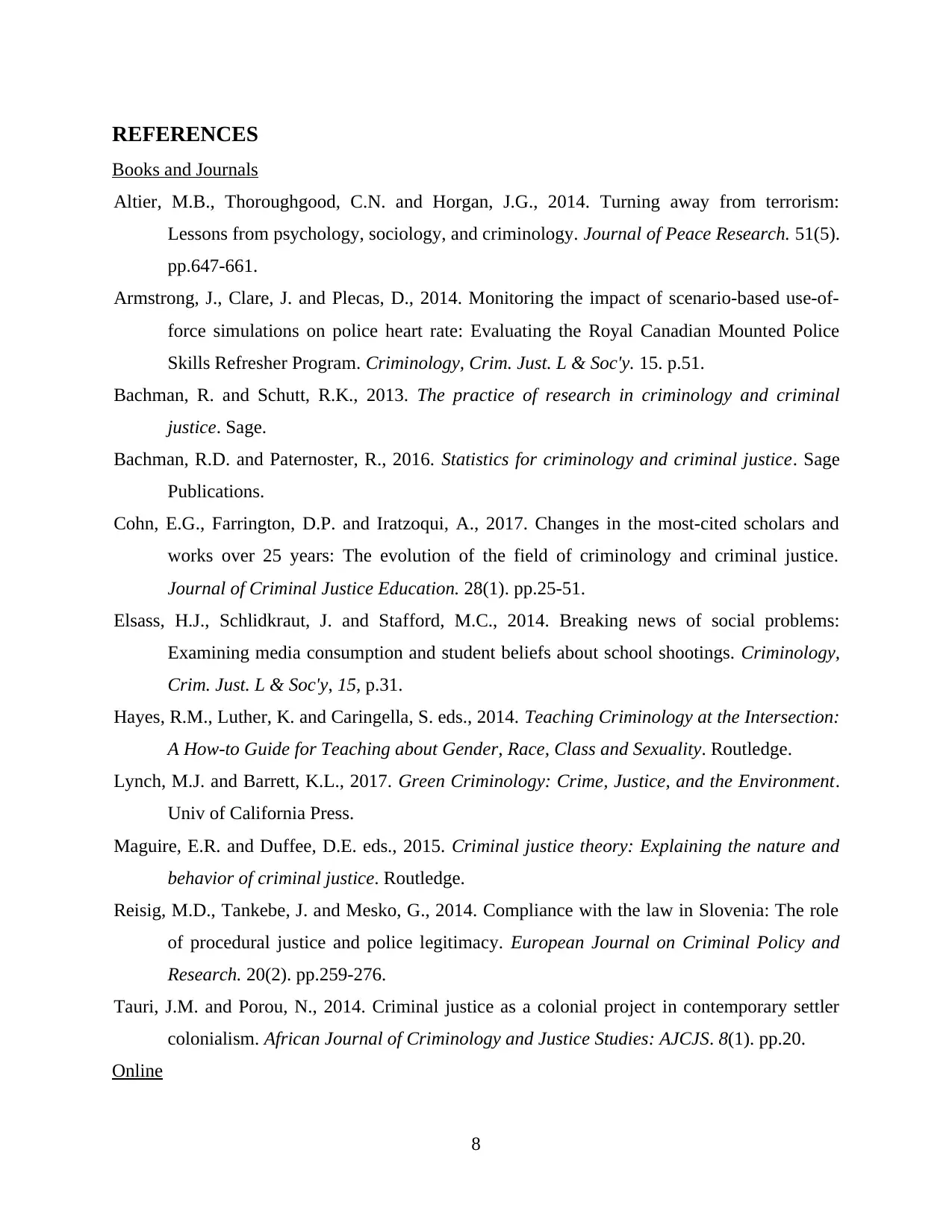
REFERENCES
Books and Journals
Altier, M.B., Thoroughgood, C.N. and Horgan, J.G., 2014. Turning away from terrorism:
Lessons from psychology, sociology, and criminology. Journal of Peace Research. 51(5).
pp.647-661.
Armstrong, J., Clare, J. and Plecas, D., 2014. Monitoring the impact of scenario-based use-of-
force simulations on police heart rate: Evaluating the Royal Canadian Mounted Police
Skills Refresher Program. Criminology, Crim. Just. L & Soc'y. 15. p.51.
Bachman, R. and Schutt, R.K., 2013. The practice of research in criminology and criminal
justice. Sage.
Bachman, R.D. and Paternoster, R., 2016. Statistics for criminology and criminal justice. Sage
Publications.
Cohn, E.G., Farrington, D.P. and Iratzoqui, A., 2017. Changes in the most-cited scholars and
works over 25 years: The evolution of the field of criminology and criminal justice.
Journal of Criminal Justice Education. 28(1). pp.25-51.
Elsass, H.J., Schlidkraut, J. and Stafford, M.C., 2014. Breaking news of social problems:
Examining media consumption and student beliefs about school shootings. Criminology,
Crim. Just. L & Soc'y, 15, p.31.
Hayes, R.M., Luther, K. and Caringella, S. eds., 2014. Teaching Criminology at the Intersection:
A How-to Guide for Teaching about Gender, Race, Class and Sexuality. Routledge.
Lynch, M.J. and Barrett, K.L., 2017. Green Criminology: Crime, Justice, and the Environment.
Univ of California Press.
Maguire, E.R. and Duffee, D.E. eds., 2015. Criminal justice theory: Explaining the nature and
behavior of criminal justice. Routledge.
Reisig, M.D., Tankebe, J. and Mesko, G., 2014. Compliance with the law in Slovenia: The role
of procedural justice and police legitimacy. European Journal on Criminal Policy and
Research. 20(2). pp.259-276.
Tauri, J.M. and Porou, N., 2014. Criminal justice as a colonial project in contemporary settler
colonialism. African Journal of Criminology and Justice Studies: AJCJS. 8(1). pp.20.
Online
8
Books and Journals
Altier, M.B., Thoroughgood, C.N. and Horgan, J.G., 2014. Turning away from terrorism:
Lessons from psychology, sociology, and criminology. Journal of Peace Research. 51(5).
pp.647-661.
Armstrong, J., Clare, J. and Plecas, D., 2014. Monitoring the impact of scenario-based use-of-
force simulations on police heart rate: Evaluating the Royal Canadian Mounted Police
Skills Refresher Program. Criminology, Crim. Just. L & Soc'y. 15. p.51.
Bachman, R. and Schutt, R.K., 2013. The practice of research in criminology and criminal
justice. Sage.
Bachman, R.D. and Paternoster, R., 2016. Statistics for criminology and criminal justice. Sage
Publications.
Cohn, E.G., Farrington, D.P. and Iratzoqui, A., 2017. Changes in the most-cited scholars and
works over 25 years: The evolution of the field of criminology and criminal justice.
Journal of Criminal Justice Education. 28(1). pp.25-51.
Elsass, H.J., Schlidkraut, J. and Stafford, M.C., 2014. Breaking news of social problems:
Examining media consumption and student beliefs about school shootings. Criminology,
Crim. Just. L & Soc'y, 15, p.31.
Hayes, R.M., Luther, K. and Caringella, S. eds., 2014. Teaching Criminology at the Intersection:
A How-to Guide for Teaching about Gender, Race, Class and Sexuality. Routledge.
Lynch, M.J. and Barrett, K.L., 2017. Green Criminology: Crime, Justice, and the Environment.
Univ of California Press.
Maguire, E.R. and Duffee, D.E. eds., 2015. Criminal justice theory: Explaining the nature and
behavior of criminal justice. Routledge.
Reisig, M.D., Tankebe, J. and Mesko, G., 2014. Compliance with the law in Slovenia: The role
of procedural justice and police legitimacy. European Journal on Criminal Policy and
Research. 20(2). pp.259-276.
Tauri, J.M. and Porou, N., 2014. Criminal justice as a colonial project in contemporary settler
colonialism. African Journal of Criminology and Justice Studies: AJCJS. 8(1). pp.20.
Online
8
Paraphrase This Document
Need a fresh take? Get an instant paraphrase of this document with our AI Paraphraser

Criminal Justice, 2015. [PDF]. Available through:
<https://www.kent.ac.uk/courses/pdfs/criminal-justice-and-criminology.pdf>. Accessed on:[30
Oct, 2017].
9
<https://www.kent.ac.uk/courses/pdfs/criminal-justice-and-criminology.pdf>. Accessed on:[30
Oct, 2017].
9
1 out of 11
Related Documents
Your All-in-One AI-Powered Toolkit for Academic Success.
+13062052269
info@desklib.com
Available 24*7 on WhatsApp / Email
![[object Object]](/_next/static/media/star-bottom.7253800d.svg)
Unlock your academic potential
Copyright © 2020–2025 A2Z Services. All Rights Reserved. Developed and managed by ZUCOL.





